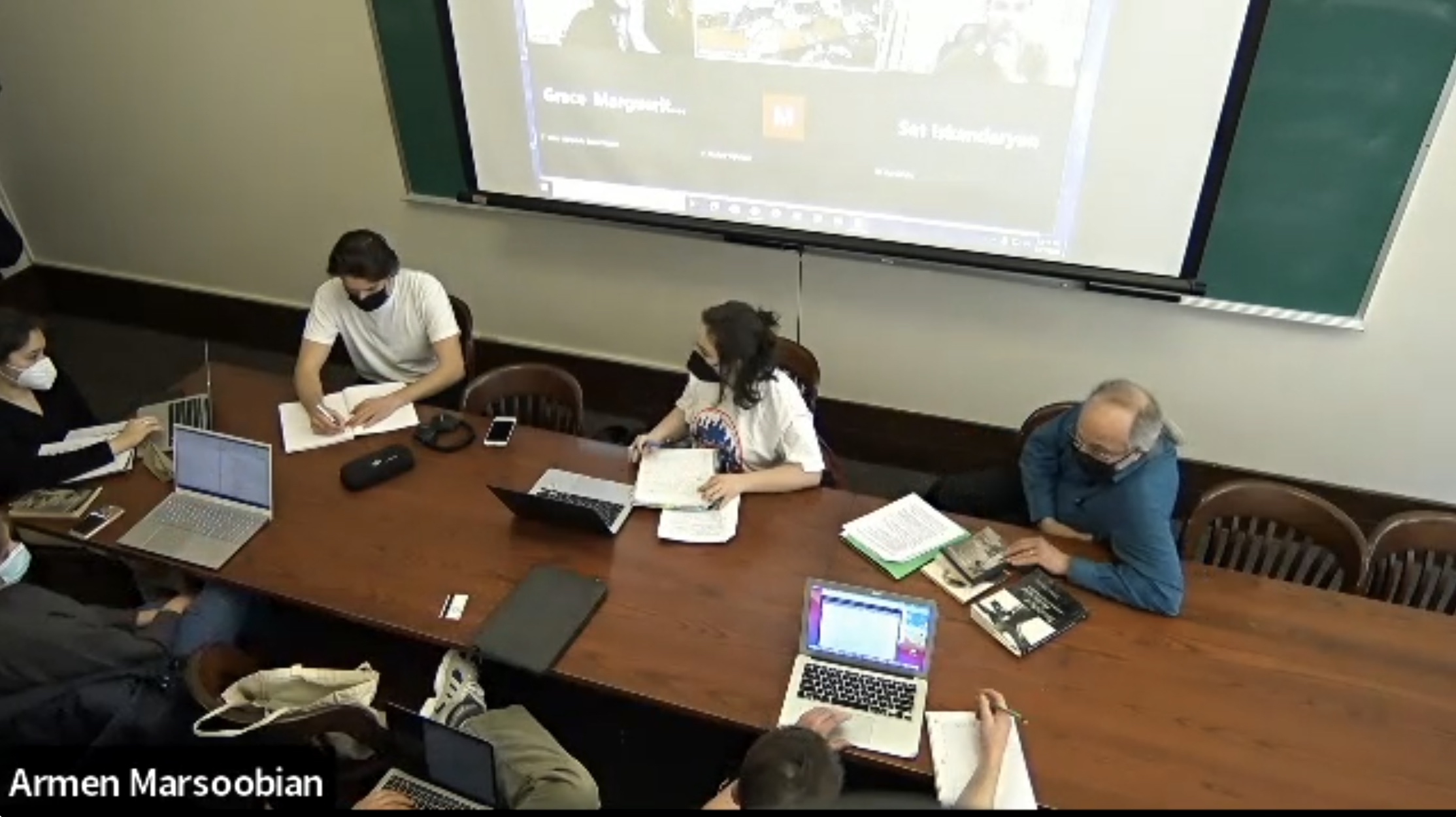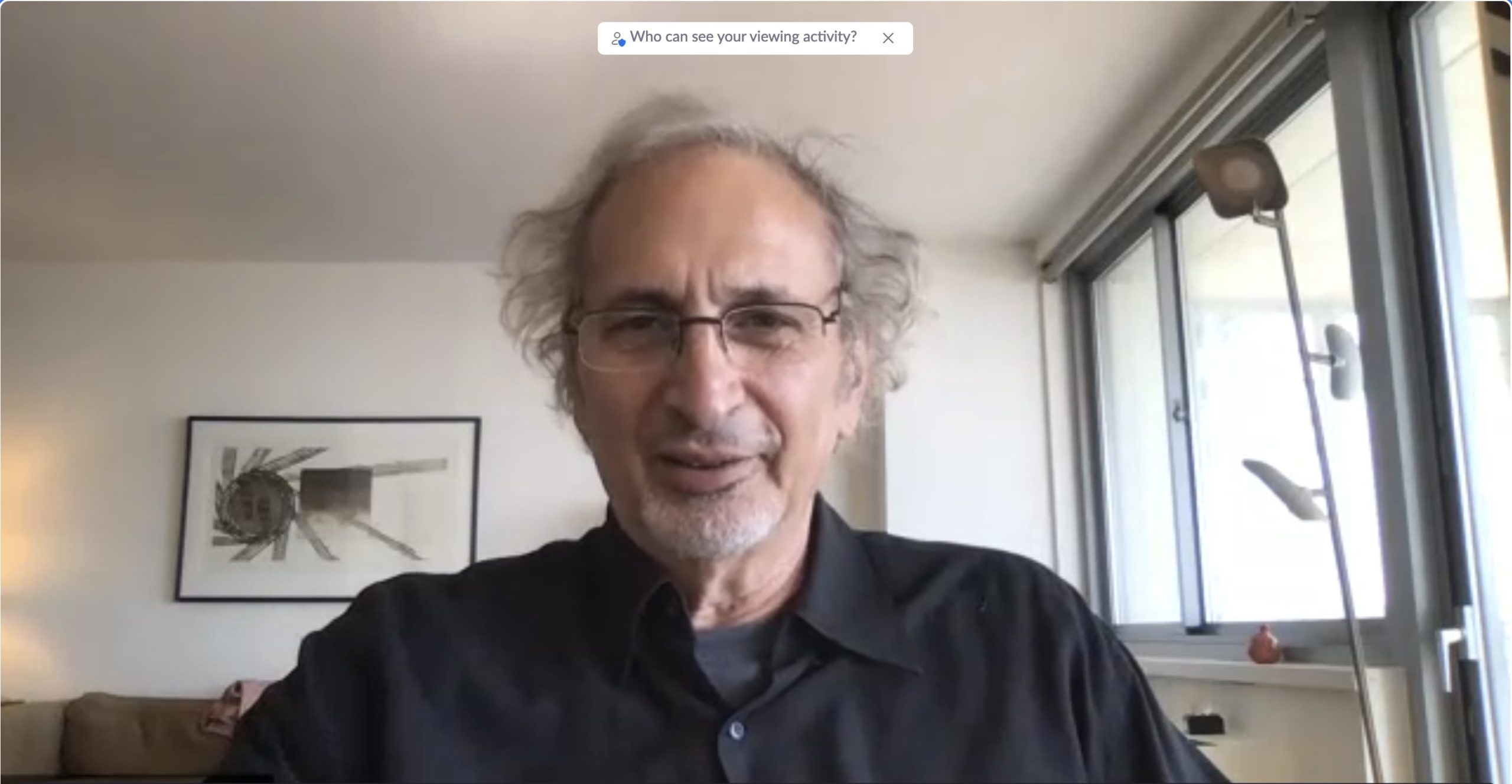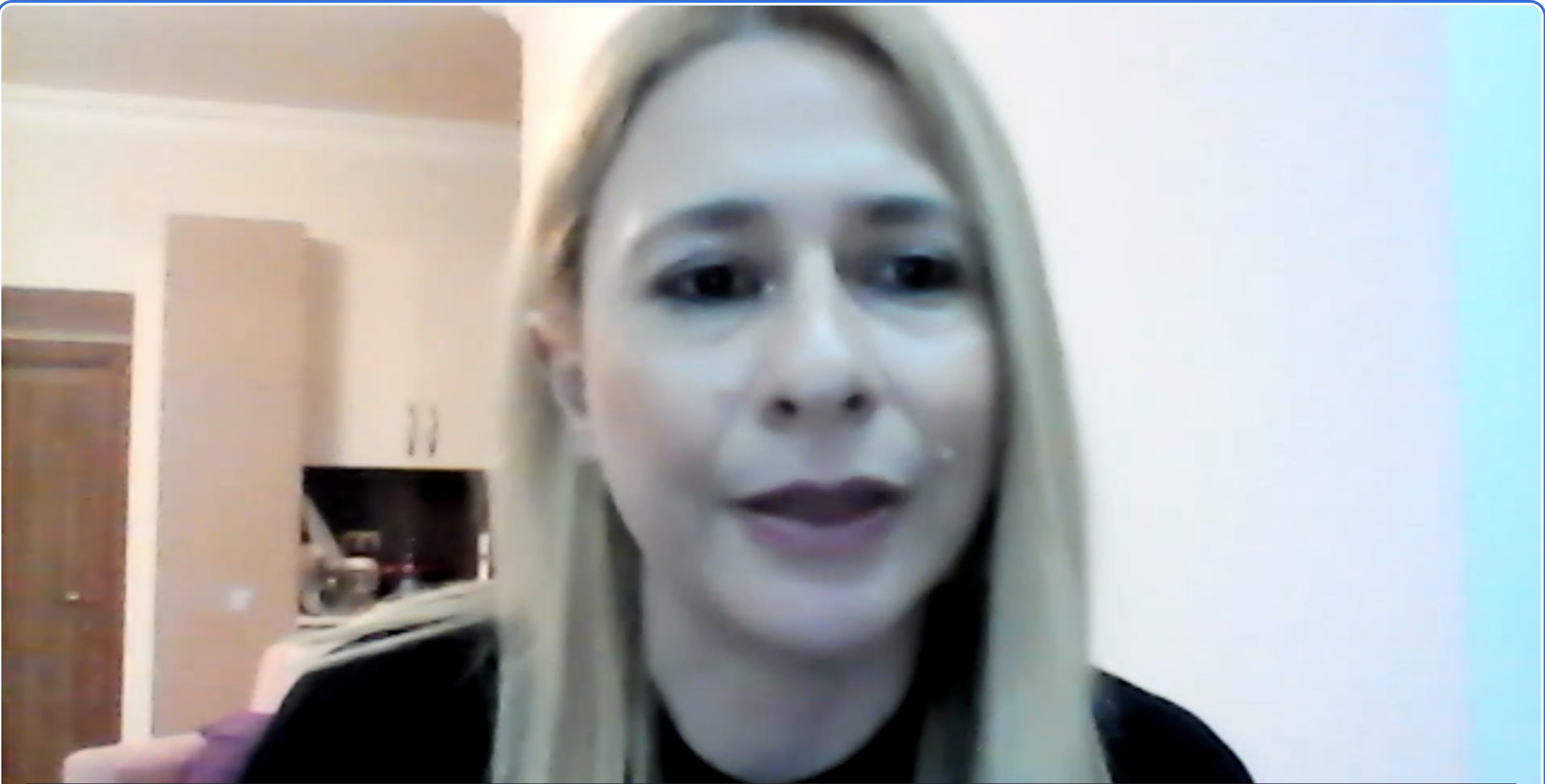
Columbia University in New York City offers a variety of opportunities for students to explore topics in Armenian studies through their Middle East, South Asian and African Studies (MESAAS) department. The just concluded academic year gave students the opportunity to experience a range of offerings, including modern history, arts and culture and the Armenian language. As the Nikit and Eleanora Ordjanian visiting professor, I was once again privileged to teach a graduate course for the department. The Ordjanian position brings scholars with a variety of academic specializations to campus. A talented group of 10 students, primarily composed of graduate students from a range of academic programs, participated in my spring seminar titled, “The Resilience of Memory: Literary and the Visual Arts in the Aftermath of the Armenian Genocide.” Together we explored topics related to my scholarship in memory studies, the arts and philosophy. In addition to my course, Dr. Khatchig Mouradian continued his association with the department, teaching his highly regarded and popular course, “Urban Space and Conflict in the Middle East,” in which Armenian issues were raised in the broader context of the Middle East. Armenian language courses continue to be taught at all levels by Charry Karamanoukian. Armenian studies at Columbia will be enhanced as the program expands in the coming year.
My seminar took a multi-disciplinary approach to Armenian responses to the Genocide and the violence that both preceded and followed the events of 1915 to 1923. Survivors of these crimes and their descendants have long sought justice and reparations, while also struggling to keep alive the memory of all that was lost. The literary, performing and visual arts play key roles in resisting the destruction of memory. Genocide is a crime whose aim is not just the annihilation of individuals, but of social groups and their cultural heritage. The arts in the form of poetry, memoir, drama, photography, film and painting have been employed to combat the forgetting, the denial and the distorting of genocidal crimes. Our seminar explored all these artforms. With the use of our classroom’s technology, we engaged virtually with artists, activists and theorists from around the world. Our guests joined us from San Francisco, London, Toronto, Yerevan and Istanbul.
Before exploring the wealth of artistic creativity that lay ahead of us, the theoretical foundations of our journey were first established through a close reading of scholars who have explored the relationships between genocidal violence, trauma and memory. These included philosophers Claudia Card and Jeffrey Blustein and writers such as Primo Levi, Robert Bevan, Marianne Hirsch and Susan Sontag. Raphael Lemkin, the legal theorist and Holocaust survivor who developed the concept and invented the term “genocide,” helped us understand how cultural destruction plays a central role in all genocides.
The first artistic works we explored were products of the 1909 Adana Massacres. These included the poetry of Siamanto’s Bloody News from My Friend and Zabel Yessayan’s journalistic memoir In the Ruins. These two works had a strong and enduring impact on the students, many of whom returned to these works again and again in their class discussions and essays. Our first virtual guests, filmmaker Garo Berberian and producer and poetry consultant Tatevik Ayvazyan, joined us from London to discuss their 2018 film Taniel. The film dramatically recreates Daniel Varoujan’s last days, aesthetically merging spoken renditions of his poetry in Western Armenian with English subtitles. Screenwriter Ben Hodgson provides a poetic English narrative, voiced over by Sean Bean, adding to the film’s emotional impact. Zadig Perrot, a graduate film studies student from France, provided our class with important insights into this film and the others we explored this semester. Given the diverse talents and backgrounds of the students in the seminar, we were all able to learn from each other’s areas of expertise.
Poetry, either in translation or originally written in English, played a central role in the class. In addition to Siamanto and Varoujan, we read the poetry of Vahan Tekeyan, Yegishe Charents, Helene Philibosian, David Kherdian, Diana Der Hovanessian, Vahram Tatigian, Nair Kuzmich and Peter Balakian. Balakian was our next virtual guest, who engaged in conversation with the students about his poetic process and his memoir Black Dog of Fate. Balakian also read from his new book of poetry No Sign. Later in the semester, we read another important memoir, Peter Najarian’s The Artist and His Mother. As was the case with Balakian, the author explores his relationship with his grandmother, a Genocide survivor whose life was forever marked by the tragedy of 1915. The silence of the survivor generation is a theme that recurred many times in the seminar. Two short documentary films—Karina Epperlein’s I Will Not be Sad in this World and Suzanne Khardalian’s Grandma’s Tattoos (the former about Najarian’s grandmother)—explore this theme of silence and generational trauma.

The visual arts were represented through our examination of the earliest film representation of genocide, director Oscar Apfel’s 1919 film Ravished Armenia. The film now only survives in fragments. The students learned about the film’s chief protagonist Aurora Mardiganian and her exploitation for the cause of humanitarian relief. The cinematic rendition of Mardiganian’s story was supplemented by video testimony that she gave many years later of her experience during the Genocide. Students also had the opportunity to view a theatrical performance piece based on Mardiganian’s story, Auction of Souls, written and performed by Arsinée Khanjian. Khanjian joined us for a lively virtual discussion of her work via Zoom. The students later viewed her screen performance in Atom Egoyan’s 2002 film, Ararat.

We shifted from the moving image to the still image, exploring photography’s central role in memory studies about mass violence and trauma. Chapters from Marianne Hirsch’s The Generation of Postmemory were discussed in which she explores issues surrounding the role that the photographic image plays in post-Holocaust memory and art. We were fortunate that Professor Hirsch was able to join us in person since she teaches in the Comparative Literature Department at Columbia. In addition to answering questions about her work, she shared with us the artistic memory work of Silvina Der-Meguerditchian and the Houshamadyan Project and website. Additionally, we had an online guest from London that day—art historian David Low, whose important new book on Ottoman Armenian photography, Picturing the Ottoman Armenian World: Photography in Erzerum, Harput, Van and Beyond, had just been released by I. B. Tauris publishing. I was also able to share my work on the Dildilian photography archive and how it has been used in exhibitions in Turkey and by students in digital media classes focusing on human rights. A lively and sometimes intense discussion ensued about the use and possible abuse of historical Armenian photographs in our digital age.
Arshile Gorky played a major role in the course. We devoted a week to examining his work and his life story. Unfortunately, due to the mounting of the Whitney Museum’s Biennial, none of his paintings, including his seminal work The Artist and His Mother were on view at the museum. We viewed and discussed three recent films about Gorky’s life and the Armenian origins of his art, including a recent collaboration between Egoyan and composer Mary Kouyoumdjian, They Will Take My Island. These were supplemented in the following weeks by a screening of Egoyan’s earlier groundbreaking feature film, Ararat.
The concluding weeks saw further cinematic explorations of the Genocide. The Promise directed by Terry George and the Turkish-German filmmaker Fatih Akin’s The Cut were the major focus. Along with these feature films, the students were asked to view Joe Berlinger’s documentary Intent to Destroy: Death, Denial & Depiction, which employs the making of The Promise as the narrative thread on which to build a comprehensive examination of not just the event of the Genocide, but the over 100-year effort to deny its occurrence and suppress its depiction.

Two additional guests joined us toward the conclusion of the semester. Carel Bertram, Professor Emerita in Middle East and Islamic Studies in the Department of Humanities at San Francisco State University, joined us to discuss her recently published book A House in the Homeland, Armenian Pilgrimages to Places of Ancestral Memory. Having traveled with Bertram in historic Armenia, I could also share with students some of my own discoveries and the meanings they held for my personal memory work and writing. Nayat Karaköse from the Hrant Dink Foundation of Istanbul joined us remotely from Yerevan where a temporary exhibition of the 23.5 Hrant Dink Site of Memory was taking place. The site is physically located in the former Agos newspaper offices where Dink was the editor and in front of which he was assassinated in 2007. Karaköse explained the motivation behind creating this site and took the class on a virtual tour of its many spaces. Students also viewed a recent film System Memory Too Low for Words, exploring Dink’s life and his reflections on being an Armenian growing up and working in a country often hostile to his minority identity as an Armenian.

We reserved our last regular class meeting to bring our exploration of genocidal violence up to the present moment with the 2020 Artsakh War and the ongoing destruction of Armenian cultural heritage in the Caucasus. Disappointingly, there was little knowledge of these events among the non-Armenian students in the class. This was not all that surprising given the lack of media attention to the war and the region. Thoughtful discussions followed, especially given the sharp contrast to the media attention given to the ongoing war in Ukraine that continues to dominate the news cycle. The Armenian students were acutely aware of the continuing violence in the Caucasus. Haley Zovickian, who was completing her master’s in sociology commented how our class “deepened her interest…in the far-reaching consequences of denialism” and that “now more than ever it is important to critically engage with Armenian history and literature and to link them to the current day.” She voiced a sentiment held by others that “Azerbaijan’s ethnic cleansing of the indigenous Armenians of Artsakh…is a disturbing and alarming parallel to the Armenian Genocide. Genocide denied is genocide repeated.”
Finals week was reserved for student presentations of final research projects. Students chose to either explore more deeply works assigned for the class or bring in new works that were related to the themes we explored. Daniel Hewett, a business major, who commented that he “didn’t know much about the Armenian Genocide prior to taking the class,” explored the notion of the lost or silenced father in the art and literature assigned for the class. In addition to the film The Cut and the Balakian and Najarian memoirs, he probed additional poems from Tekeyan’s Sacred Wrath, a collection assigned for the class. I learned much from his reading of the poetry. He shared with me a gratifying anecdote. After reading excerpts from the two memoirs to his mother, she bought copies of the books and took them home to Florida to read.
Leah Hickert, a graduate student pursuing a degree in international affairs, conveyed a similar experience. “Even though I specialized in Middle Eastern Area Studies in both undergraduate and graduate school, I regret to say that I had heard only fleeting references of the Armenian Genocide, often in comparative contexts and likened to the plight of the Kurds or Palestinians…As someone who has extensively studied other horrific, historic atrocities, I was still stunned to learn—and have a visceral reaction to—the wanton disregard for life and human dignity in the Armenian Genocide. Moreover, I had never understood the extent to which Turkish government officials continue to hide the mass violence their state inflicted under the guise of ‘national security,’ a feeble excuse for the dehumanization of entire groups that we still hear in political rhetoric today. As horrific as it was to learn about the details of the Armenian Genocide, it was equally as inspiring to learn about the ways in which Armenians and their descendants have resiliently fought the blatant silencing of their shared history through multimedia platforms and activism. It reminded me that as a person who is not part of the shared history of the Armenian people or many other victimized groups, it is my responsibility not only to educate myself on historical atrocities to prevent their repetition, but also to consider the burden still carried by those whose legacies have been repressed and the awe-inspiring ways they continue to work through grief towards remembrance.”
The two graduate students from Istanbul, one of whom, Ares Zerunyan, had Armenian heritage, shared that their Turkish education had deprived them of much knowledge of the Armenians on their lands and was completely silent regarding 1915. Zerunyan, a history master’s student, wrote the following: “As a Turkish-Armenian, this course was very important for me. Throughout my time in school and as an undergraduate I never had the opportunity to really learn specifically about the Armenian Genocide. What I really valued about the course was its perspective…I really loved learning about Arshile Gorky and talking to Peter Balakian about his poetry, as these were all figures that I had encountered through my own reading and research. On a personal note, the course helped me feel a greater sense of Armenian identity through learning, but also being in a classroom setting with fellow Armenians who brought refreshing ideas about memory and also connected the course to more contemporary issues such as the war in Artsakh.” The Turkish architectural doctoral student also told me that she intentionally took the class to make up for what was withheld from her during her education in Turkey.
One of the most gratifying aspects of teaching is to know that you have made an impact that lasts well beyond the final class. In my case, I cannot take full credit for such an impact, for it was the Armenian artists, poets, filmmakers and writers who deserve most of the credit. As Zadig Perrot wrote in a correspondence weeks after the semester ended: “As a Frenchman whose Armenian community was never too far away (especially as I was always avid for my grandfather’s lessons) yet never as structuring and numerous as it is for some of my classmates, you allowed me to discover beautiful works and given me an outlet to finally learn so much more about one of my two peoples. I was especially moved by the words of Siamanto and Tekeyan, even if I know they must lose so much in translation, and I will use my time after graduation wisely in reading more of their poems.” My only regret is that I will not be reading these poems again with this group of bright, motivated and intellectually engaged students.


Be the first to comment